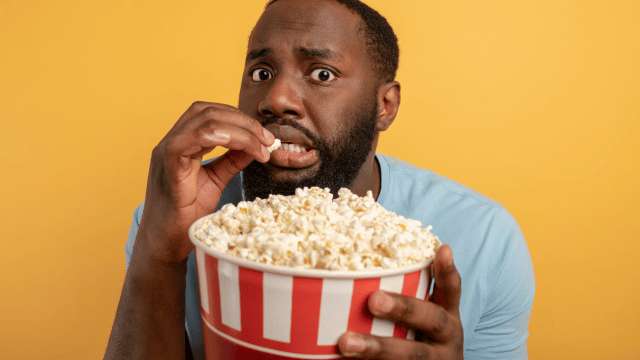Horror films have long captivated audiences with their spine-chilling narratives, jump scares, and twisted characters. But beyond the entertainment value, these movies have a profound influence on society. From shaping cultural perceptions to reflecting societal fears, horror films offer a unique lens into the human psyche.
One of the primary ways horror movies impact society is by tapping into our deepest fears and anxieties. By confronting and exaggerating these fears on screen, these films allow viewers to experience a cathartic release, offering a temporary escape from their own real-life horrors. The adrenaline rush and the thrill of being scared in a controlled environment can provide a sense of excitement and a break from the monotony of everyday life. Moreover, the physiological reactions caused by fear, such as increased heart rate and heightened senses, can create a sense of exhilaration.
However, the psychological impact of horror films goes beyond the immediate experience. Studies have shown that exposure to horror movies can desensitize individuals to real-life violence, making them less reactive to distressing situations. This phenomenon, known as the “fear inoculation” effect, suggests that repeated exposure to simulated fear can help individuals build resilience and cope better with real-world challenges. Additionally, horror films can serve as a form of exposure therapy for individuals with specific phobias, allowing them to confront their fears in a controlled environment.
Overall, the psychological impact of horror films is complex and multifaceted. While they can provide a temporary escape and desensitize viewers to fear, they can also be a form of catharsis and exposure therapy for some individuals.
The Evolution of Horror Film Genres
Over the years, horror films have evolved and diversified, giving rise to various subgenres that cater to different tastes and preferences. From classic slasher films like “Halloween” to supernatural horror movies like “The Conjuring,” each subgenre offers a unique blend of terror and suspense. This evolution has allowed horror films to appeal to a wider audience and explore new themes and narratives.
One notable subgenre that has gained popularity in recent years is psychological horror. These films focus on the psychological torment of the characters, often blurring the line between reality and imagination. Movies like “Psycho” and “Get Out” delve into the depths of the human psyche, leaving audiences questioning their own perceptions of reality. This subgenre taps into our innate fears of the unknown and the complexity of the human mind, offering a more introspective and thought-provoking experience.
Another subgenre that has seen a resurgence is found footage horror. Films like “Paranormal Activity” and “The Blair Witch Project” utilize a documentary-style approach, creating a sense of realism and immersion. This subgenre capitalizes on our fascination with the unknown and the supernatural, often leaving audiences with a lingering sense of unease long after the movie ends.
The evolution of horror film genres not only keeps the genre fresh and interesting but also allows filmmakers to explore different themes and narratives, catering to a diverse audience.
Horror Films as a Reflection of Societal Fears and Anxieties
Horror movies often serve as a reflection of societal issues and fears, providing commentary on topics like gender roles, the unknown, or even political unrest. These films act as a mirror, amplifying and exaggerating the anxieties of society.
One example of horror films reflecting societal fears is the rise of zombie movies. These films depict a world ravaged by a pandemic or an apocalyptic event, tapping into our collective fear of disease outbreaks and societal collapse. The popularity of zombie movies like “Night of the Living Dead” and “World War Z” coincides with periods of social and political unrest, highlighting our anxieties about the fragility of civilization.
Furthermore, horror films often explore gender roles and power dynamics. Films like “Carrie” and “The Babadook” delve into the fears and struggles faced by women, challenging traditional gender norms and giving voice to marginalized experiences. By portraying female protagonists who defy societal expectations and confront their fears, these movies empower and inspire audiences.
In addition to societal fears, horror films also reflect cultural anxieties and the unknown. Movies like “The Exorcist” and “The Omen” explore themes of religion and spirituality, delving into our fear of the supernatural and the unexplainable. These films tap into our fascination with the unknown and our desire to comprehend the mysteries of the universe.
By reflecting societal fears and anxieties, horror films provide a platform for dialogue and introspection, forcing us to confront uncomfortable truths and examine our own fears.
The Influence of Horror Films on Popular Culture
Horror films have had a profound influence on popular culture, permeating various aspects of entertainment and media. From iconic characters to memorable quotes, these movies have left an indelible mark on our collective consciousness.
One notable example is the impact of horror films on the music industry. Artists like Michael Jackson and Lady Gaga have drawn inspiration from horror movies, incorporating elements of horror and the macabre into their music videos and stage performances. The visual aesthetics and thematic elements of horror films have become a source of inspiration for musicians across different genres.
Moreover, horror films have also spawned a vast array of merchandise and fan communities. From action figures to clothing lines, fans of horror movies can express their love for the genre through various forms of merchandise. Additionally, horror conventions and film festivals provide a space for fans to come together, celebrate their favorite movies, and engage with the creators and actors behind them.
Furthermore, horror films have influenced other forms of media, such as literature and video games. Books like “Dracula” and “Frankenstein” have become literary classics, inspiring countless adaptations and spin-offs. In the world of video games, horror-themed titles like “Silent Hill” and “Resident Evil” have gained a dedicated following, immersing players in terrifying and suspenseful experiences.
The influence of horror films on popular culture is undeniable, shaping our tastes, inspiring creativity, and fostering a sense of community among fans.
The Role of Horror Films in Shaping Societal Norms and Values
Horror films have the power to challenge societal norms and redefine cultural values. By presenting alternative perspectives and exploring taboo subjects, these movies can push boundaries and provoke thought.
One example of horror films challenging societal norms is the representation of LGBTQ+ characters and themes. Movies like “Bride of Frankenstein” and “A Nightmare on Elm Street 2: Freddy’s Revenge” have been analyzed for their subtextual queer narratives, offering a queer reading of the horror genre. These films provide a space for marginalized communities to see themselves represented on screen and challenge heteronormative narratives.
Furthermore, horror films can also critique social and political institutions. Movies like “The Purge” and “Get Out” offer social commentaries on issues like systemic racism and class inequality, using horror elements as metaphors for real-world injustices. By highlighting these issues in a visceral and unsettling way, these films provoke conversations and encourage audiences to critically examine societal norms.
Additionally, horror films can challenge traditional gender roles and stereotypes. Movies like “Scream” and “The Descent” feature strong female protagonists who defy expectations and fight back against their tormentors. These films subvert the trope of the helpless victim and empower women, challenging gender norms and inspiring audiences.
Through their ability to challenge societal norms and redefine cultural values, horror films have the potential to shape our perceptions and promote social change.
The Controversy Surrounding Horror Films
While horror films have a dedicated fan base and have become a staple of popular culture, they have also faced criticism and controversy. The graphic violence, explicit content, and disturbing imagery often associated with the genre have sparked debates about their impact on individuals and society.
Critics argue that horror films perpetuate violence and desensitize viewers to real-world suffering. They claim that the explicit and graphic nature of these movies can lead to increased aggression and a diminished sense of empathy. Additionally, some argue that the portrayal of violence, especially against women, in horror films can reinforce harmful stereotypes and perpetuate misogyny.
However, proponents of horror films argue that the genre can be a form of catharsis and allow individuals to confront their fears in a controlled environment. They contend that the violence depicted in these movies is fictional and that viewers are capable of distinguishing between fantasy and reality. Moreover, they argue that horror films offer valuable social commentary and provide a platform for marginalized voices.
The controversy surrounding horror films highlights the complex and subjective nature of their impact on individuals and society. While some see them as a source of entertainment and empowerment, others view them as harmful and problematic.
The Positive Effects of Horror Films on Individuals and Society
Despite the controversy surrounding horror films, there is evidence to suggest that they can have positive effects on individuals and society. From providing a sense of community to fostering critical thinking, these movies offer more than just scares.
One positive effect of horror films is their ability to create a sense of community among fans. Horror conventions and film festivals provide a space for like-minded individuals to come together, share their love for the genre, and engage with fellow enthusiasts. This sense of community can be empowering and create a support network for individuals who may feel marginalized or misunderstood.
Moreover, horror films can foster critical thinking and media literacy. By analyzing the themes, symbolism, and underlying messages in these movies, viewers can develop their analytical skills and engage in thoughtful discussions. Horror films often require audiences to think beyond the surface-level scares and delve into deeper meanings, encouraging a more active and discerning approach to media consumption.
Additionally, horror films can inspire creativity and artistic expression. Filmmakers like Guillermo del Toro and Jordan Peele have cited horror movies as a major influence on their work, using the genre as a platform to explore complex themes and tell compelling stories. The creativity and innovation within the horror genre have contributed to the evolution of filmmaking as a whole.
The positive effects of horror films on individuals and society underscore their cultural significance and the value they offer beyond mere entertainment.
The Future of Horror Films and Their Impact on Society
As technology advances and societal fears evolve, the future of horror films holds endless possibilities. New storytelling techniques, immersive experiences, and diverse narratives will continue to push the boundaries of the genre and captivate audiences.
Advancements in virtual reality (VR) and augmented reality (AR) present exciting opportunities for the horror genre. These technologies have the potential to create even more immersive and interactive experiences, allowing viewers to step into the terrifying worlds of their favorite horror movies. The ability to fully immerse oneself in a horror narrative can enhance the emotional impact and create a more visceral and intense experience.
Furthermore, the inclusion of diverse voices and perspectives in horror films will continue to shape the genre and challenge existing norms. Filmmakers from underrepresented communities are bringing fresh perspectives and narratives that explore different fears and anxieties. This diversification of the genre not only brings new stories to the forefront but also allows for a more inclusive and representative portrayal of society.
The future of horror films is also intertwined with advancements in storytelling techniques and special effects. From innovative camera techniques to cutting-edge visual effects, filmmakers will continue to push the boundaries of what is possible on screen. These advancements will enhance the horror experience, immersing viewers in terrifying and awe-inspiring worlds.

